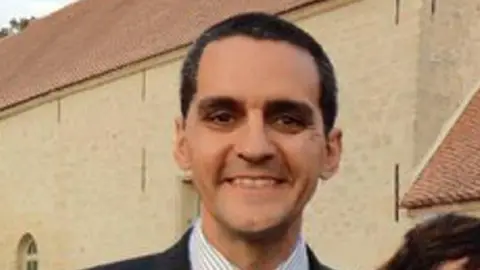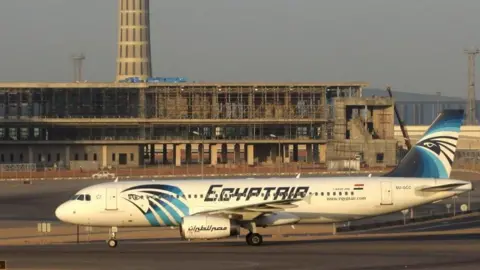Cockpit fire caused EgyptAir crash that killed Welshman
 Athena Picture Agency
Athena Picture AgencyA Welsh geologist was killed along with 65 others when the plane he was travelling on plunged into the sea following a fire in the cockpit, an inquest has concluded.
Richard Osman, who was born and brought up in Carmarthen, was on EgyptAir flight MS804 when it vanished in May 2016.
The 40-year-old was travelling from Paris to Cairo, where he was due to spend a few days on business, when the plane plunged into the Mediterranean.
An inquest hearing in Llanelli on Friday, which recorded a narrative conclusion, heard how flames fuelled by an oxygen leak "took hold" of the aircraft, causing electrical failures which saw the pilots lose control prior to descent.
Mr Osman, who held a masters degree in mining geology, had boarded the plane on the evening of 18 May 2016 for a business trip.
He was working and living in Jersey, with his wife Aurelie Vandeputte and their two young daughters, at the time of his death.
Reading a victim impact statement at the hearing, Ms Vandeputte said her husband was a "charismatic yet humble young man" who loved rugby and running and was "proud of his Welsh-Egyptian background".
She described Mr Osman as "autonomous and self-driven", known for his "sense of humour, generosity and openness" and close to his family.
She added he was "respected by all" within the mining industry, with a scholarship created by his peers in his memory.
The couple had led a "global" life, living in Paris, Brussels, London, Athens and Egypt before settling in Jersey.
Their daughters - now aged 11 and nine - were two years and 22 days old respectively at the time of their father's death.
Ms Vandeputte said she received no formal, face-to-face notification of her husband's death, and was left with no news for long periods of time, left as the sole parent of two young children to nurse "irreparable wounds".
"It was survival for many years… [now] I will hopefully be able to begin a new chapter," she said.
Mr Osman was one of four children and, in a statement read in court, his younger sister Anna said she "looked up to and loved" him "with all my heart".
"My thirties were engulfed with grief… it's a weight I will carry with me for the rest of my life," she said.
 AirTeamImages
AirTeamImagesThe people on board the plane were made up of 59 passengers, two flight crew and five cabin attendants and there were no survivors.
The night-time flight went missing after it entered Greek airspace, and crashed at one of the deepest areas of the Mediterranean sea - more than 3,000m (9,800ft) in some parts.
Wreckage and life jackets were found 230 miles (370km) south of the Greek island of Crete.
Smoke had been detected in the toilet and the avionics area, which contained the aircraft's electronics and computer below the cockpit.
Aviation expert Kenneth Fairbank told the hearing the aircraft had been properly maintained and the crew on board had sufficient experience.
He said a cockpit recording device picked up a hissing sound, followed by a popping sound and then the crew announced the fire - all in the space of a few seconds.
Shortly after, there were "multiple computer equipment failures" due to "a lot of the electrical connectors [being located] in an area of the flight deck that was affected by the fire", he said.
'Conflicting reports'
Mr Fairbank explained there were "conflicting reports" regarding the cause of the fire.
The Egyptian air accident investigation report concluded there was a "detonation of an explosive device secreted in the forward galley", the area just behind the cockpit.
But the French investigation reported it was instead likely the fire started in an oxygen mask storage box within the cockpit.
Mr Fairbank said he believed "the weight of the evidence does not support an on-board explosion".
He added that, while the fire ignition source was unknown, "it certainly does seem to be an oxygen-fed fire".
He added the aircraft flew for more than 13 minutes following the hissing noise and there was "lack of transparency" around reported traces of explosives found.
"It is clear that a fire ignited and took hold of the aircraft… [which] maneuvered and descended in an uncontrolled manner," he said.
"In this scenario, it would not have been possible to fight the fire."
Addressing some media reports, which included a suggestion that a pilot smoking in the cockpit caused the fire, Mr Fairbank said there was "no evidence" of this, adding he believed the theory to be "solely based on the fact that Egyptian aircraft pilots were known to be able to smoke at that time".
He also disputed a separate suggestion that the release valve on the oxygen tank had been left in the emergency position by maintenance staff, leading to the oxygen leak, saying while the mask had been recently replaced, the aircraft had flown nine times between then and the crash.
Assistant coroner Mark Layton recorded a narrative conclusion, saying he "fully accepts" that "on the balance of probabilities" the crash was caused by a fire of unknown ignition source but likely fuelled, if not also started, by the oxygen tank unit.
He gave his condolences to Mr Osman's family and said work would now begin on a prevention of future deaths report, reflecting safety recommendations highlighted in both the French and Egyptian investigation reports.
